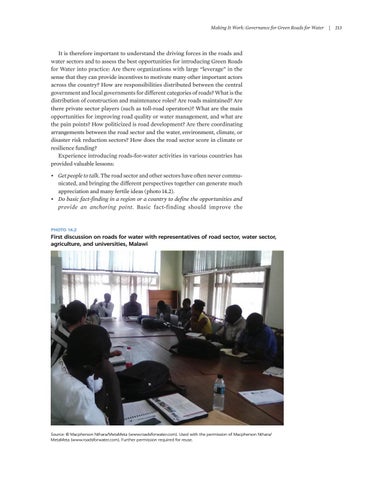Making It Work: Governance for Green Roads for Water | 213
It is therefore important to understand the driving forces in the roads and water sectors and to assess the best opportunities for introducing Green Roads for Water into practice: Are there organizations with large “leverage” in the sense that they can provide incentives to motivate many other important actors across the country? How are responsibilities distributed between the central government and local governments for different categories of roads? What is the distribution of construction and maintenance roles? Are roads maintained? Are there private sector players (such as toll-road operators)? What are the main opportunities for improving road quality or water management, and what are the pain points? How politicized is road development? Are there coordinating arrangements between the road sector and the water, environment, climate, or disaster risk reduction sectors? How does the road sector score in climate or resilience funding? Experience introducing roads-for-water activities in various countries has provided valuable lessons: • Get people to talk. The road sector and other sectors have often never communicated, and bringing the different perspectives together can generate much appreciation and many fertile ideas (photo 14.2). • Do basic fact-finding in a region or a country to define the opportunities and provide an anchoring point. Basic fact-finding should improve the
PHOTO 14.2
First discussion on roads for water with representatives of road sector, water sector, agriculture, and universities, Malawi
Source: © Macpherson Nthara/MetaMeta (www.roadsforwater.com). Used with the permission of Macpherson Nthara/ MetaMeta (www.roadsforwater.com). Further permission required for reuse.







































